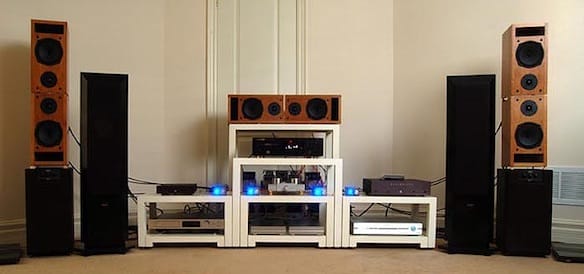
Image credit: Six Moons.
Building an Entry Level Sound System
For this entry in the Priceonomics Audiophile Guide, we will look at putting together an introductory sound system. We will examine an assembly from a digital audio source (computer, or portable music player, iproducts) and one from a traditional source (turntable, cd player, tape source). The digital system will be considered in terms of a desktop arrangement, while the traditional system will be directed towards a listening room.
Building a Computer Audio System
As the first thing to upgrade on a computer-driven sound system is the playback quality of the stock digital-to-analog converter on the sound card, we will plug in an outboard DAC. The Nu Force uDAC-2 is a good affordable choice. As the uDAC-2 doubles as a headphone amplifier, it is as simple as plugging the speaker outputs from the computer or music player into the uDAC-2, and plugging in some headphones.
Blaupunkt, Koss and Clarion all make affordable headphones with respectable performance specifications. The Blaupunkt 112 Silver Edition headphones have a little more ear padding and provide an eight-foot long cable for your listening flexibility.
With the inclusion of some gourmet cables, we have now radically improved the sound performance of your computer or music player’s audio playback for under $200. Believe it or not, most listeners report a superior response to headphones than to speakers, but as the Nu Force uDAC also has RCA outputs, we will also look at playback through speakers.
The Bose Companion 2 ($100) or the Audioengine A2 ($200) will be the desktop speakers of choice for this reviewer. Either will provide a large voice, and the Audioengine will approach response levels one would expect from a listening room, as opposed to a computer or an iphone. There are a myriad of desktop computer speaker systems available for under $100, some quite impressive, but we are attempting to provide a superior audiophile-level listening experience.
Building a Standalone Audiophile Sound System
For a stand-alone introductory sound system we will begin traditionally, with a turntable for playing vinyl LPs. The Denon DP-29F is a belt-driven turntable that comes with a moving-magnetic cartridge, and has discreet circuitry to minimize noise from the motor being introduced into the signal path. It may be operated manually or automatically, an issue of contention among audiophiles.
The Onkyo M-282 is a 100-watt power amplifier, for around $240, with adjustable audio input levels that can accommodate preamp input stage power levels, enabling this unit to be daisy-chained . A Pro-Ject Phono Box MM phono preamp will optimize stage input levels from the turntable, and we will run this signal directly to speakers. It retails for around $120.
The Polk Audio RTi A5 is a ported speaker tower that seems unable to garner a negative review. At roughly $400 per pair, built with two 6-1/2” woofers and a 1” silk-polymer tweeter, they represent a significant portion of our sample system investment. The Audioengine A5+ provides slightly less frequency range, with a single 5” woofer and ¾” tweeter. Around the same price point the Klipsch reference RF-52 are feature two 5-1/4” woofers with a 1” titanium dome tweeter, for a little less money.
For those cringing at floor speaker prices, there are many bookshelf speakers that will provide a roomful of sound. The Polk Audio TSi-100 bookshelf line is available for a little over $200. For those who want to hybrid their digital source with a traditional stereo configuration, the dual-source Russound x-75 amplifier in conjunction with a USB turntable, like the Denon DP-200 USB will provide excellent flexibility for activities like archiving vinyl recordings, in addition to pure listening pleasure.
For those of less traditional aspirations, there is a trend in the CD player industry to make very inexpensive transports that meet spectacular specs. Sony and Toshiba make single-play cd transports that support DVDs for under $50. A Yamaha SD 300 will provide discreet circuitry and quality components, as well as USB capability for around $300.
And here Priceonomics illustrates how to know audiophile-level sound experience from a system that costs under $1000.



